
Osceola County is a county located in the central portion of the U.S. state of Florida. As of the 2020 census, the population was 388,656. Its county seat is Kissimmee. Osceola County is included in the Orlando–Kissimmee–Sanford, Fla. Metropolitan Statistical Area.

Fort Meade is a city in Polk County, Florida, United States. As of 2020, the population recorded by the U.S. Census Bureau is 5,100. It is part of the Lakeland–Winter Haven Metropolitan Statistical Area.

Klondike Gold Rush National Historical Park is a national historical park operated by the National Park Service that seeks to commemorate the Klondike Gold Rush of the late 1890s. Though the gold fields that were the ultimate goal of the stampeders lay in the Yukon Territory, the park comprises staging areas for the trek there and the routes leading in its direction. There are four units, including three in Municipality of Skagway Borough, Alaska and a fourth in the Pioneer Square National Historic District in Seattle, Washington.

Broadway, until 1890 Fort Street, is a thoroughfare in Los Angeles County, California, United States. The portion of Broadway from 3rd to 9th streets, in the Historic Core of Downtown Los Angeles, was the city's main commercial street from the 1910s until World War II, and is the location of the Broadway Theater and Commercial District, the first and largest historic theater district listed on the National Register of Historic Places (NRHP). With twelve movie palaces located along a six-block stretch of Broadway, it is the only large concentration of movie palaces left in the United States.
The Alfred B. Maclay State Gardens is a 1,176-acre (4.76 km2) Florida State Park, botanical garden and historic site, located in Tallahassee, in northeastern Florida. The address is 3540 Thomasville Road.

The Louisiana State Museum (LSM), founded in New Orleans in 1906, is a statewide system of National Historic Landmarks and modern structures across Louisiana, housing thousands of artifacts and works of art reflecting Louisiana's legacy of historic events and cultural diversity.

The Old Lake Worth City Hall, also known as the Lake Worth City Hall Annex, is a historic site in Lake Worth Beach, Florida. It is located at 414 Lake Avenue.
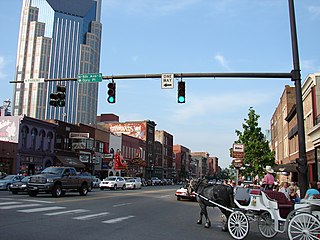
Broadway is a major thoroughfare in the downtown area in Nashville, Tennessee. It includes Lower Broadway, an entertainment district renowned for honky tonks and live country music.

The Albany Institute of History & Art (AIHA) is a museum in Albany, New York, United States, "dedicated to collecting, preserving, interpreting and promoting interest in the history, art, and culture of Albany and the Upper Hudson Valley region". It is located on Washington Avenue in downtown Albany. Founded in 1791, it is among the oldest museums in the United States.

The Rev. Wm James Reid House is a historic frame vernacular home, located in Fort Meade, Florida and was built between 1899-1914. It was built over another structure sometime in the late 1880s, as the lot appears in an 1880s survey. The property which compromises of Orange Ave and Oak St were part of the Jack Robeson addition, which the house sits on today. One of the last two surviving carriage stones in Polk County was located in front of the home for more than 100 years. It was originally owned by Reverend William James Reid (1858–1931) and Stella C. Reid (1869–1954) from Hanceville, Alabama. Mr. Wm James Reid was a minister for the North Alabama Conference Methodist Church South. The home was later owned by his son Claude 'Cauntess' Reid (1894–1976), who lived in the house until his death in 1976. After Claude's death, the home was left in the possession of his sister Carrie B. Reid (1898–2001). The home was left vacant for many years and was then sold to the Harpe family sometime around 1985.

The Karpeles Manuscript Library Museums is one of the largest private collections of historic manuscripts and documents in the world. It was founded in 1983 by California real estate magnates David Karpeles and Marsha Karpeles, with the goal of stimulating interest in learning, especially in children, and to make the collection more accessible, is distributed among many Karpeles museums across the US, each located in a historic building, plus "mini-museums" in schools and office buildings. Items are rotated between museums quarterly, and each of the museums presents a daily general exhibit and one or more special scheduled exhibits throughout the year. In addition, Karpeles is aggressively expanding the content of its website. All of the Karpeles Manuscript Library services are free. The museums are located in small and midsize cities, although the Karpeles family put on an exhibit in Central Park West in New York City in 1991. As of June 2023, there are ten museums.

The Randolph Street Commercial Buildings Historic District is a historic district located in Downtown Detroit, Michigan, which includes six buildings along Randolph Street between Monroe and Macomb streets. The district was listed on the National Register of Historic Places in 1980. The collection of buildings are a rare surviving set of Detroit Victorian-era commercial structures. The Randolph Street Commercial Building Historic District joins the Broadway Avenue Historic District downtown.
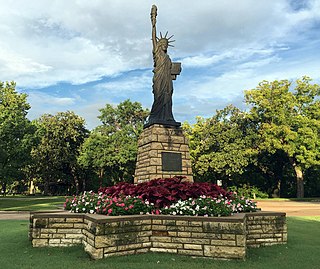
Strengthen the Arm of Liberty is the theme of the Boy Scouts of America's fortieth anniversary celebration in 1950. The campaign was inaugurated in February with a dramatic ceremony held at the base of the Statue of Liberty. Approximately 200 BSA Statue of Liberty replicas were installed across the United States.

The Albany Monteith Historic District, also known as Monteith Historic District, in Albany, Oregon, United States, was listed on the National Register of Historic Places (NRHP) in 1980. It includes the Alfred Dawson House, which is separately listed on the NRHP. The district was expanded in 2008.
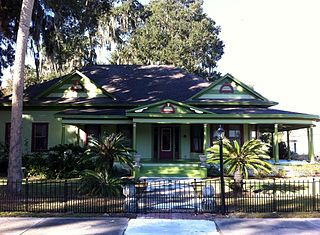
The W.O. Williams/R.C. McClellan House is an historic home in Fort Meade, Florida.
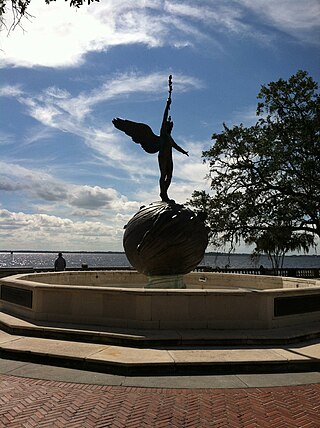
Riverside and Avondale are two adjacent and closely associated neighborhoods, alternatively considered one continuous neighborhood, of Jacksonville, Florida. The area is primarily residential, but includes some commercial districts, including Five Points, the King Street District, and the Shoppes of Avondale.
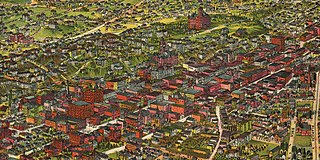
The late-Victorian-era Downtown of Los Angeles in 1880 was centered at the southern end of the Los Angeles Plaza area, and over the next two decades, it extended south and west along Main Street, Spring Street, and Broadway towards Third Street. Most of the 19th-century buildings no longer exist, surviving only in the Plaza area or south of Second Street. The rest were demolished to make way for the Civic Center district with City Hall, numerous courthouses, and other municipal, county, state and federal buildings, and Times Mirror Square. This article covers that area, between the Plaza, 3rd St., Los Angeles St., and Broadway, during the period 1880 through the period of demolition (1920s–1950s).

















